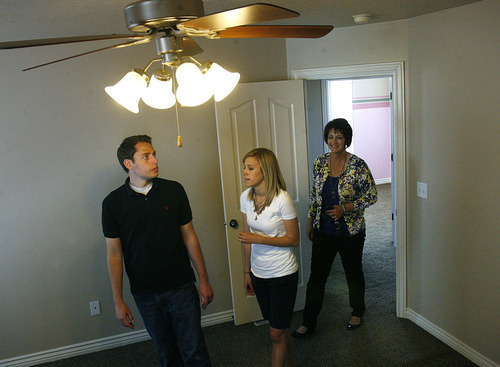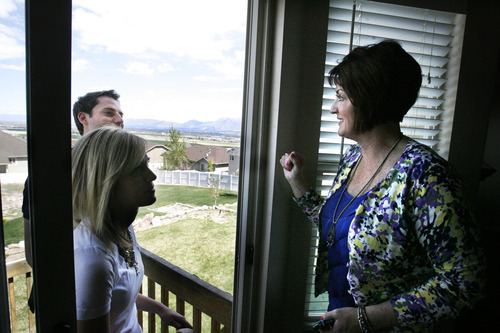This is an archived article that was published on sltrib.com in 2012, and information in the article may be outdated. It is provided only for personal research purposes and may not be reprinted.
Multiple offers. Sellers getting more than their asking prices. Homes selling within days or weeks, instead of months.
Although the signs of an improving real estate market aren't yet widespread, they are beginning to be seen in greater frequency along the Wasatch Front, especially at lower price ranges. Although it's still a buyer's market, this is shaping up to be the most active springtime home-buying season in five years.
"I'm working 10-11 hour days for the first time in four years," said Donna Pozzuoli, president of the Salt Lake Board of Realtors. "Things have really picked up."
In the first quarter of the year, 2,156 homes sold in Utah's most populous county, up 18 percent from 1,830 during the same three-month period in 2011, the Salt Lake Board of Realtors reported.
Home values, however, have not stopped falling in many areas of Utah's most populous region. The median single-family home price fell to $190,500, down almost 5 percent from $200,000 in the first quarter of 2011 and a peak of $256,000 in the summer of 2007. The same trend of home-sale increases and selling-price declines can be seen in most areas along the Wasatch Front.
But the price declines are starting to get smaller, and in some areas values are even stable compared to last year. But more importantly, sales generally are up substantially over last year, a particularly bad year for Utah real estate. The amount of time homes remain on the market before they sell also is moving in the right direction, in Salt Lake County falling an average of 13 percent to 122 days over the past year.
Nearly five years after the housing downturn began, the combination of improving state and national economies, better job growth, a rise in consumer confidence and super-low mortgage rates finally are helping to bring some life back to the battered sector, albeit ever so slowly.
"If the housing market here hasn't yet bottomed, I think it's near that point," said home buyer Chace Larsen.
A new job and low mortgage rates helped convince Chace and wife Madison that this is the right time to buy. The couple moved from Houston to Utah in March so Chace Madison could take a job as a financial analyst with an oil company in the Salt Lake area.
He and his wife could have elected to rent and wait for prices to completely bottom before buying. But Larsen didn't want to miss out on mortgage rates of around 4 percent. "Interest rates are so good," he said. The couple put in an offer on a new home in Herriman and expect to close any day.
Randy Hulbert of Salt Lake City was surprised at the high level of interest in his home in the week after he put it on the market for just under $265,000. By the second week, Hulbert and his wife were sorting through multiple offers that started lower than the asking price but quickly moved back up. By day 13, their home was under contract.
"Now, we have to sweat out the appraisal," he said.
Because the buyers are taking out a mortgage to purchase the home, the lender wants to make sure they aren't paying too much. One issue in today's market is that appraisals are coming back at values lower than what buyers have agreed to pay. In those cases, sellers may have to lower the amount they are willing to accept. Since the housing downturn began, appraisers are more carefully — and conservatively — determining the values of residential properties.
The housing bubble burst along the Wasatch Front in the summer of 2007 after several years of escalating home prices. Lax and even questionable lending, in which almost anyone could qualify for a home loan, gave way to tight lending criteria in which many could not qualify. The economy plunged into the Great Recession. In the years that followed, home sales and prices plummeted as many potential buyers faced pay cuts and job losses.
As a result, there has been a general reluctance to buy for much of the past five years, even with historically low interest rates.
Today, as a host of corporate expansions are luring more people to the state, many of the newcomers are buying homes rather than renting. Today's low interest rates, plus the threat that rates will increase after the presidential election, are pushing some fence-sitters to act.
The average rate on a 30-year home loan last week was 3.88 percent, according to mortgage giant Freddie Mac. Last year at this time, 30-year fixed-rate loans were nearly 1 percentage point higher.
Because interest rates have nowhere to go but up, homes may not get any more affordable than they are now. Even if prices go down a bit more over the next year, mortgage rates may increase at the same time, offsetting any benefits.
An interest rate increase of 1 percent to 2 percent can have a tremendous impact on affordability, said Salt Lake City mortgage broker Nathan Pierce.
For example, the principal and 4-percent interest payment on a 30-year home loan of $200,000 would be $955. At 6 percent, that mortgage payment jumps to $1,200.
Just as with the stock market, though, timing an investment in a home just at the right time is difficult — even for the pros. But the uptick in home sales are definitely a sign of a market on the mend — one in which prices are likely to stabilize soon, economists say.
Mark Knold, chief economist for the Utah Department of Workforce Services, said prices have fallen to a point where potential buyers are starting to take notice, which helps explain some of the increase in home sales. And if home sales keep rising, prices will follow, he said.
"That's why I think this is the year that prices will have hit bottom," Knold said.
Economic forecasting firm Moody's Analytics also predicts home prices in Utah will hit a nadir this year, with modest home-price increases expected in 2013.
But the key word is modest. Many Utahns remain unemployed, underemployed or working for less pay and benefits than they did before the downturn. Others are in no position to buy a home because they owe more on their mortgages than their existing homes are worth and can't sell without harming their credit.
"There are still headwinds," Knold said. "We don't expect the housing market will come roaring back."
lesley@sltrib.com Twitter: @cheapchick Facebook.com/OneCheapChick —
Should I buy now?
In short, maybe. Here's why:
Prices could still fall a bit more. Know that although the market is expected to bottom out this year, it isn't there yet, especially for higher-priced homes. If you think you will have to sell in the next two years, it may not be the best idea to buy now.
On the other hand, mortgage rates are super low. At 4 percent (or less) this may be the lowest rate you'll get in a long time. As the economy begins to improve, expect mortgage rates to rise.





